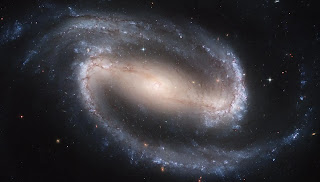One of the 15 winning proposals for NASA High Priority
Open-Source Science (HPOSS) funding will help simulate galaxies. Pictured here
is barred spiral galaxy NGC 1300, as imaged by the Hubble Space Telescope.
NASA, ESA, and The Hubble Heritage Team (STScI/AURA)
Acknowledgment: P. Knezek (WIYN)
NASA awarded $1.4 million to 15
teams developing new technologies that advance and streamline the open sharing
of scientific information.
High Priority Open-Source Science (HPOSS) awards fund projects that aim to
increase the accessibility, inclusivity, or reproducibility of NASA’s Science
Mission Directorate (SMD) research. Projects include open-source tools,
software, frameworks, data formats, or libraries that will have a significant
impact to the SMD science community. HPOSS awards are for one year and
approximately $100,000.
The HPOSS solicitation is one of
several cross-divisional funding opportunities funded by NASA’s Office of the Chief Science
Data Officer (OCSDO) with a focus on advancing open science practices. These
solicitations are unique among NASA’s annual omnibus solicitation for basic and
applied research, Research Opportunities in Space and Earth Science (ROSES), providing cross-divisional support for
new work with strong potential to advance the adoption of open science
practices across SMD.
“We are excited to be able to fund
these opportunities to enable modern research through NASA’s support of open
science,” said Chelle Gentemann, program officer for HPOSS and open science
program scientist for OCSDO at NASA Headquarters in Washington, D.C. on an
Intergovernmental Personnel Act assignment from the International Computer
Science Institute. “Open science is crucial in improving the transparency,
security, and reproducibility of scientific research.”
The HPOSS solicitation for
ROSES-2024 is currently available as F.14 on NSPIRES. Under ROSES-2024, HPOSS has expanded to include the
development of capacity-building materials, like curricula, tutorials, and
other training materials, reflecting the program’s commitment to fostering open
science practices.
The HPOSS solicitation has no
fixed due date. Proposers are encouraged to submit their proposals via NSPIRES at any
time. Proposals are evaluated by peer review panels and selections are made
throughout the year.
“The proposals selected thus far
illustrate the breadth of this solicitation, ranging from projects that will
increase the accessibility of data relevant to specific research communities to
open-source tools that will be relevant across multiple SMD divisions,” said
Gentemann.
The selected awardees for the
ROSES-22 and ROSES-23 calls are:
Roses-2022 Awardees
Erin Buchanan, Harrisburg
University of Science & Technology, Harrisburg, Pennsylvania
STAPLE: Science Tracking Across the Project Lifespan
James Colliander / Code For Science
And Society, INC., Portland, Oregon
Ephemeral Interactive Computing for NASA Communities
Gretchen Daily, Stanford
University, Stanford, California
Metadata Tools for More Transparent, Reproducible, and Accessible Geospatial
Analysis
Douglas Moore, 39 Alpha Research,
Tempe, Arizona
Dorothy: Making Scientific Data Transparent, Accessible, and Reproducible
Matthew Turk, University of
Illinois, Urbana-Champaign, Champaign, Illinois
Synergistic Software Tooling for Geophysical and Astrophysical Analysis:
Linking yt and Xarray
Richard Townsend, University of
Wisconsin, Madison, Wisconsin
Catalyzing an Open-Source Ecosystem for the GYRE Stellar Oscillation Code
Andrew Jiranek, Sciencecast Inc.,
Towson, Maryland
Advancing Equitable Scientific Publishing through Open-Science Digital
Innovations
Jami Montgomery, Georgetown
University, Washington, District of Columbia
Web-based Planetary Topography Toolkit
Roses-2023 Awardees
Russell Turner, Oregon State
University, Corvallis, Oregon
Creation of an Open Access 3-Dimensional Image and Data Library for Rat
Bones from Space Shuttle Experiments
Hans-Peter Marshall / Boise State
University, Boise, Idaho
The SnowEx DB Open-Source Project -- Standardized Data Access to Maximize
Mission Data Use and Accelerate Research
Leila DeFloriani / University of
Maryland, College Park, Maryland
An Open-Source Library for Processing Forest Point Clouds Based on
Topological Data Analysis
Michael Phillips / University of
Arizona, Tucson, Arizona
Spectral Cube Analysis Tool: A Python Graphical User Interface for Analyzing
Spectral Image Data
Julie Barnum / University of
Colorado, Boulder, Colorado
A Heliophysics Software Search Interface Portal
Benjamin Keller / University of
Memphis, Memphis, Tennessee
Portable and Reproducible Initial Conditions for Galaxy Simulations
Ryan Curtin / NumFocus, Austin,
Texas
Enhance Usability and Discoverability of mlpack for Low-Resource Spaceflight
Machine Learning
Summaries of previously selected
proposals can be found under the “Selections” section on the HPOSS NSPIRES
pages for ROSES-2022 and ROSES-2023.
To learn more about the HPOSS
program element, a recording of a recent informational webinar is available, along with the presentation slides.
To learn more about NASA open
science funding opportunities, visit: science.nasa.gov/open-science/nasa-open-science-funding-opportunities/
By: Lauren Leese
Source: NASA
Awards 15 Grants to Support Open-Source Science - NASA Science













.gif)
.gif)
.gif)
.gif)
.gif)
.gif)
.gif)
.gif)
.gif)
.gif)
.gif)
.gif)
.gif)
.gif)
.gif)
.gif)
.gif)
.gif)
.gif)
.gif)










.gif)
.gif)
.gif)
.gif)
.gif)
.gif)
.gif)
.gif)
.gif)
.gif)
.gif)
.gif)
.gif)
.gif)
.gif)
.gif)
.gif)
.gif)
.gif)